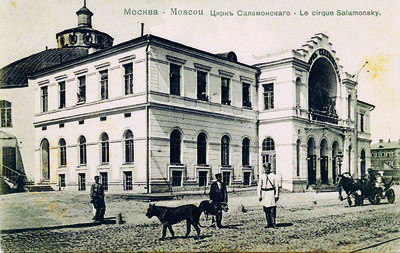Difference between revisions of "Main Page"
From Circopedia
| Line 44: | Line 44: | ||
==New Videos== | ==New Videos== | ||
| + | * [[Simet_Trio_Video_(2013)|Simet Trio]], Koch Semaphore Act (2013) | ||
* [[Uvve_Jansson_Video_(2011)|Uvve Jansson]], Swinging Trapeze (2011) | * [[Uvve_Jansson_Video_(2011)|Uvve Jansson]], Swinging Trapeze (2011) | ||
* [[Trushin_Troupe_Video_(2013)|Trushin Troupe]], Teeterboard Act (2013) | * [[Trushin_Troupe_Video_(2013)|Trushin Troupe]], Teeterboard Act (2013) | ||
* [[Galkynysh_Troupe_Video_(2013)|Galkynysh Troupe]], Cossack Riding Act (2013) | * [[Galkynysh_Troupe_Video_(2013)|Galkynysh Troupe]], Cossack Riding Act (2013) | ||
* [[Aleksandrov-Fedotov_Video_(1965)|Aleksandrov-Fedotov]], Tiger Act (1965) | * [[Aleksandrov-Fedotov_Video_(1965)|Aleksandrov-Fedotov]], Tiger Act (1965) | ||
| − | |||
==Featured Oral Histories== | ==Featured Oral Histories== | ||
Revision as of 01:46, 21 November 2013
|
In The Spotlight
THE CIRCUSES OF MOSCOW
Although the name Moscow Circus is familiar to the public all over the world, there has never been one specific “Moscow Circus” whose troupe toured internationally. The name was a generic term for the circus shows from the USSR traveling abroad during the Soviet Era. It has, over time, become synonymous with “Russian circus.” Yet, there are today (2013) two resident circuses in Moscow, Circus Nikulin on Tsvetnoy Boulevard, and the Bolshoi Circus (bolshoi means big, in Russian) on Vernadsky Avenue—and there have been indeed several others before them.
The first circus built in Russia was established by the French equestrian Jacques Tourniaire, who settled in 1827 in what was then the Russian capital, St. Petersburg. The building, designed by the architect Smaragd Shustov and named Cirque Olympique, was located near the Fontanka canal, practically where St. Petersburg’s Bolshoi State Circus (the former Circus Ciniselli) stands today. Tourniaire’s circus had only a short existence: it was bought back by the government of St. Petersburg in 1828 to be transformed into a theater. Still, the event didn’t fail to catch the attention of the Muscovites, who always took exception to the influence of Peter The Great’s Baltic capital.... (more...)
New Biographies
- Nikolai Pavlenko, Animal Trainer
- The Durov Dynasty, Clowns, Animal Trainers
- The Circuses Of Moscow, History
- Menno Van Dyke, Juggler
- Desire Of Flight, Aerialists
New Videos
- Simet Trio, Koch Semaphore Act (2013)
- Uvve Jansson, Swinging Trapeze (2011)
- Trushin Troupe, Teeterboard Act (2013)
- Galkynysh Troupe, Cossack Riding Act (2013)
- Aleksandrov-Fedotov, Tiger Act (1965)
Featured Oral Histories
- Nikolai Pavlenko, tiger trainer - Interview (RIA Novosti, 2012)
- Alberto Zoppé, Equestrian - Interview (McCutcheon & Distasio, 2003)
- Olivier Taquin, Mime - Interview (Jando, 2008)
- Barry Lubin, Clown (Grandma) - Interview (Jando, 2008)
- Fumagalli, Clown - Interview (Jando, 2008)
A Message from the Editor
CIRCOPEDIA is a constantly evolving and expanding encyclopedia of the international circus. New videos, biographies, essays, and documents are added to the site on a weekly—and sometimes daily—basis. So keep visiting us: even if today you don't find what you're looking for, it may well be here tomorrow! And if you are a serious circus scholar and spot a factual or historical inaccuracy, do not hesitate to contact us: we will definitely consider your remarks and suggestions.
- WARNING: A few videos on CIRCOPEDIA may be unavailable. Our video archive is being transferred to a new host, and the missing videos will be available again shortly. Thank you for your patience.
- Dominique Jando
- Editor/Curator
